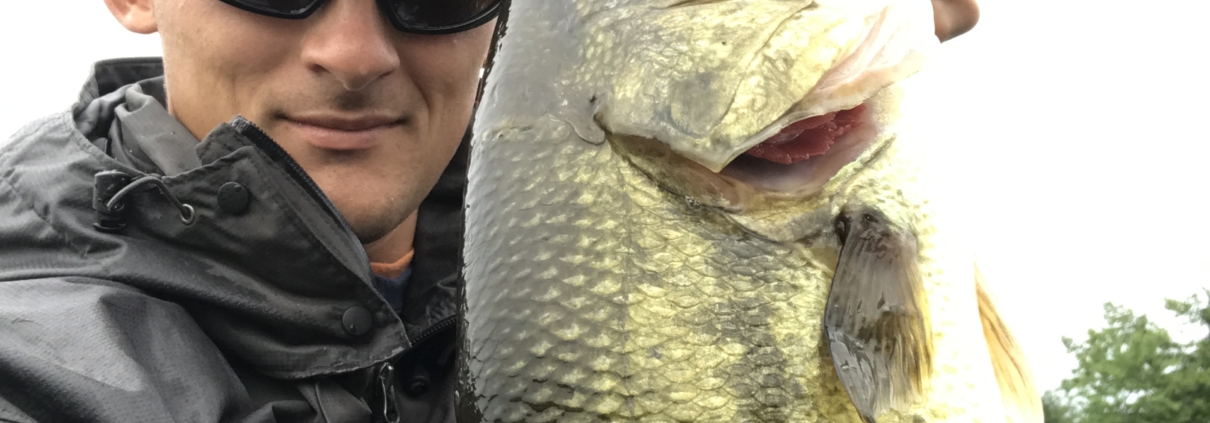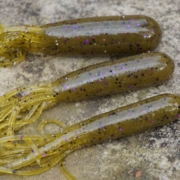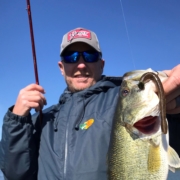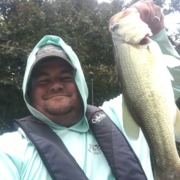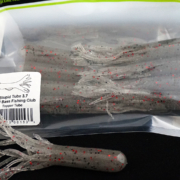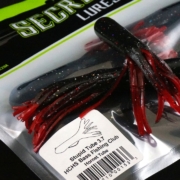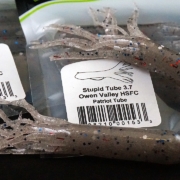Swim Jig Fishing Secrets
Northern Swim Jig Fishing
By Mike Raber
Swimming a jig has become increasingly popular over the past decade. For good reason, this technique catches big fish. The swim jig has been responsible for several elite level tournament wins in recent history. Perhaps its effectiveness is due in part to its versatility and adaptability. Anglers have employed swim jigs to catch winning sacks of bass from North to South and coast to coast. When I started fishing a swim jig many years ago, I learned the braid sizzling action of the south doesn’t always translate well to Northern waters. Creating a “system” for Northern swim jig fishing has been paramount to my successes with the technique. What I’ve learned is it really boils down to two simple facts.
- You can’t hook bass that don’t bite
- You can’t land bass that don’t stay hooked
Getting Bit
Perhaps the most important yet most simple aspect of any technique in bass fishing is getting bites. The swim jig is great at this as it covers a ton of water and offers more realism than its counterparts. There are additional things you can do to tip the odds in your favor for getting more bites, however. Matching the hatch is very important in clear water swim jig fishing. For swim jigs, matching the hatch boils down to two things, the color, and the trailer.
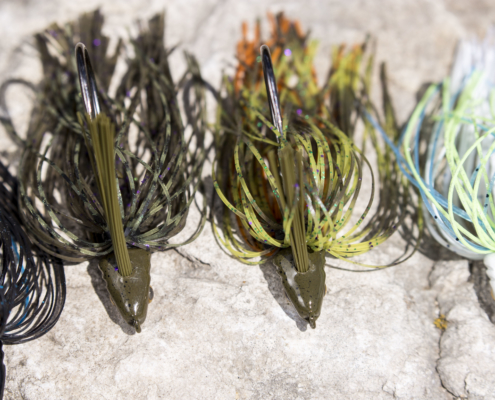
Jig Colors
I keep my colors very simple, stocking only a few options to imitate bream and a shad pattern or two. My absolute favorite jig for imitating bluegill in the Midwest is the Candy Craw color in the Secret Lures MVP Swim Jig line.
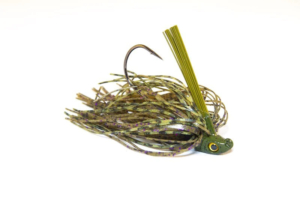
Honestly, this has been the jig I’ve reached for time and time again over the past 5 years and it flat gets bit. Having a jig you can rely on is extremely important but the jig is only half of the puzzle.
Jig Trailers
Swim jig trailers come in many shapes and sizes and I’ve narrowed my selection to keep it simple and effective… catching the theme here? The trailer should complement the jig in multiple aspects. The size, action, and color of the trailer should be coupled with the jig to create the most attractive package possible. Recognize that you can completely change your presentation simply by changing your trailer. That may sound quite complex, but I have a few favorites that seem to cover nearly all situations.
1 / 4 Ounce Swim Jig
Top trailer choices: Rage Craw / Reaction Innovations Little Dipper
The Rage Craw gets the nod in dirtier water where more water displacement is needed. It also serves well in situations where I’d like to keep the jig up in the water column and moving slowly. The Little Dipper is more versatile and serves well in any visibility 2 feet or more. This trailer helps to get the light jig a little deeper and allows it to move a little faster than the craw without blowing out.
3/8 Ounce Swim Jig
Top Trailer Choices: Keitech Fat Swing Impact
This one is very popular and predictable and it works! My favorite situation for the 3/8 ounce jig is fishing outside weed lines on our natural lakes. The extra weight allows me to keep the jig in the strike zone longer and fish it at a faster speed. I pull it out when I feel like one or the other subtle changes in retrieve or depth will make a difference. That size jig, coupled with a 3.8” Keitech is a heck of a package for clear water green fish.
Keeping Fish Buttoned
If you’re new to the technique or you’re using the wrong equipment, losing fish with a swim jig can be a huge problem. It is important that your rod, reel, and line are all working in unison to put fish in the boat.
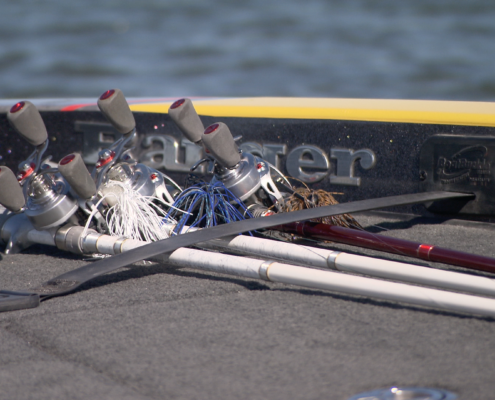
Rod Suggestions:
Use a rod that has plenty of backbone but also allows you to reel into the fish and load up on the hookset. In my opinion, the best swim jig stick on the planet is the Denali Kovert LT 723WJ. The rod handles both 1/4- and 3/8-ounce jigs very well. People vary some on their rod choice here, but I strongly suggest using something at least 7’ and something in the Medium Heavy range. Choose a swim jig rod you believe in and build your system around that.
Line:
I try to streamline everything as much as possible. For both 1/4 and 3/8 swim jigs I throw 15lb Fluorocarbon about 80% of the time. This allows me to transition from fishing a light jig up dirt shallow to slow rolling a heavier jig on deep grass lines by simply tying on a new jig. The situation where I consistently turn to a lighter line is in very cold water, where I’m looking for every advantage I can find to get a bite.
Reel:
This is the simplest part of the system. Use the fastest reel you can buy. When a five pounder inhales your jig from behind and runs at you, you’ll thank me.
What Makes a Good Swim Jig?
The three things I look for in a swim jig are realism, balance, and efficiency. I’ve used dozens of different jigs and while many of them work, I have settled on the Secret Lures MVP Swim Jig for a couple of reasons.

Realism – A swim jig must look like the baitfish it imitates. The water is usually clear when a swim jig bite is on and fish will often trail your jig before deciding to eat it. For this reason, I look for every advantage I can get. I like a jig to have realistic eyes and a lively skirt. The trailer should do the bulk of the drawing in but when that fish gets close, it can easily be the details that make the difference.
Balance – Balance comes more from the head design of the bait. Make sure the head of the jig allows it to keel upright in the water and track true at all speeds. Nothing will hang up quicker or look more unnatural than a jig swimming sideways.
Efficiency – Efficiency is all about the business end, the hook. The Secret Lures MVP Swim Jigs are one of the few that I’ve found to actually tailor the hook to the head size. That may seem like a small detail, but it is key.
A 1/4-ounce jig should sport a hook with light enough wire to not overpower the bait but should also be able to lean on a kicker and not straighten it out. A 3/8-ounce jig should do the same, but you want a stronger/heavier hook to compensate for the extra weight in the head.
Their 1/2-ounce version is actually built with a saltwater grade heavy duty hook, but I personally don’t have a lot of experience with that one…YET. With that said, all you have to do is hold one in your hand. It screams HEAVY DUTY and is just begging for braided line and big bass!
Each of these things is something I learned to be important over time with this technique. Put these pieces together and you have one heck of a swim jig. Give them a try this spring and I think they’ll quickly become one of your Secret Lures.
Keep it Simple
In summary, swim jigging truly is pretty simple if you start with a good product. You cast it out, you wind it in, it gets bites. If you take this system and make it your own, I’m sure your northern swim jig fishing will improve. Find a rod that works for your style. Find the line that you trust when your tournament is on it. Experiment with jigs and trailers until you find what you like but if you’re looking for a great place to start, look no further than the MVP Swim Jig.
If you are in my neck of the woods, Northern Indiana, stop in and see Reid and the folks at The Angler in Hudson, IN. He turned me onto these baits several years ago and he keeps a great selection of the jigs and trailers mentioned here. Make your swim jig fishing less complicated this year. Get bites, make them count, and tell us all about it when it works.

